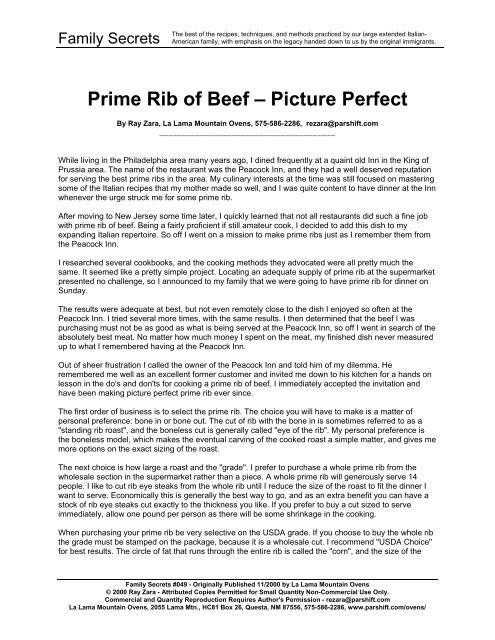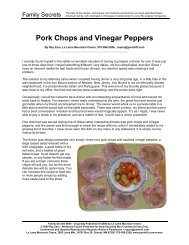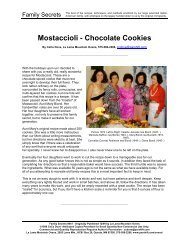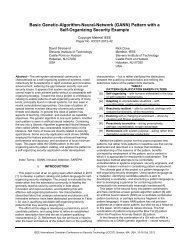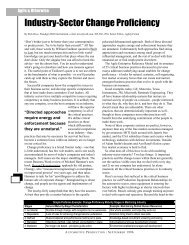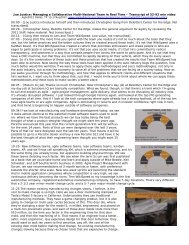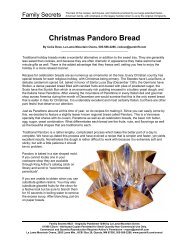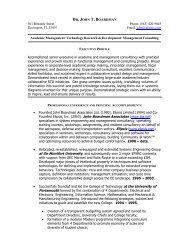Prime Rib of Beef â Picture Perfect - Paradigm Shift International
Prime Rib of Beef â Picture Perfect - Paradigm Shift International
Prime Rib of Beef â Picture Perfect - Paradigm Shift International
You also want an ePaper? Increase the reach of your titles
YUMPU automatically turns print PDFs into web optimized ePapers that Google loves.
Family Secrets<br />
The best <strong>of</strong> the recipes, techniques, and methods practiced by our large extended Italian-<br />
American family, with emphasis on the legacy handed down to us by the original immigrants.<br />
<strong>Prime</strong> <strong>Rib</strong> <strong>of</strong> <strong>Beef</strong> – <strong>Picture</strong> <strong>Perfect</strong><br />
By Ray Zara, La Lama Mountain Ovens, 575-586-2286, rezara@parshift.com<br />
_______________________________________<br />
While living in the Philadelphia area many years ago, I dined frequently at a quaint old Inn in the King <strong>of</strong><br />
Prussia area. The name <strong>of</strong> the restaurant was the Peacock Inn, and they had a well deserved reputation<br />
for serving the best prime ribs in the area. My culinary interests at the time was still focused on mastering<br />
some <strong>of</strong> the Italian recipes that my mother made so well, and I was quite content to have dinner at the Inn<br />
whenever the urge struck me for some prime rib.<br />
After moving to New Jersey some time later, I quickly learned that not all restaurants did such a fine job<br />
with prime rib <strong>of</strong> beef. Being a fairly pr<strong>of</strong>icient if still amateur cook, I decided to add this dish to my<br />
expanding Italian repertoire. So <strong>of</strong>f I went on a mission to make prime ribs just as I remember them from<br />
the Peacock Inn.<br />
I researched several cookbooks, and the cooking methods they advocated were all pretty much the<br />
same. It seemed like a pretty simple project. Locating an adequate supply <strong>of</strong> prime rib at the supermarket<br />
presented no challenge, so I announced to my family that we were going to have prime rib for dinner on<br />
Sunday.<br />
The results were adequate at best, but not even remotely close to the dish I enjoyed so <strong>of</strong>ten at the<br />
Peacock Inn. I tried several more times, with the same results. I then determined that the beef I was<br />
purchasing must not be as good as what is being served at the Peacock Inn, so <strong>of</strong>f I went in search <strong>of</strong> the<br />
absolutely best meat. No matter how much money I spent on the meat, my finished dish never measured<br />
up to what I remembered having at the Peacock Inn.<br />
Out <strong>of</strong> sheer frustration I called the owner <strong>of</strong> the Peacock Inn and told him <strong>of</strong> my dilemma. He<br />
remembered me well as an excellent former customer and invited me down to his kitchen for a hands on<br />
lesson in the do's and don'ts for cooking a prime rib <strong>of</strong> beef. I immediately accepted the invitation and<br />
have been making picture perfect prime rib ever since.<br />
The first order <strong>of</strong> business is to select the prime rib. The choice you will have to make is a matter <strong>of</strong><br />
personal preference: bone in or bone out. The cut <strong>of</strong> rib with the bone in is sometimes referred to as a<br />
"standing rib roast", and the boneless cut is generally called "eye <strong>of</strong> the rib". My personal preference is<br />
the boneless model, which makes the eventual carving <strong>of</strong> the cooked roast a simple matter, and gives me<br />
more options on the exact sizing <strong>of</strong> the roast.<br />
The next choice is how large a roast and the "grade". I prefer to purchase a whole prime rib from the<br />
wholesale section in the supermarket rather than a piece. A whole prime rib will generously serve 14<br />
people. I like to cut rib eye steaks from the whole rib until I reduce the size <strong>of</strong> the roast to fit the dinner I<br />
want to serve. Economically this is generally the best way to go, and as an extra benefit you can have a<br />
stock <strong>of</strong> rib eye steaks cut exactly to the thickness you like. If you prefer to buy a cut sized to serve<br />
immediately, allow one pound per person as there will be some shrinkage in the cooking.<br />
When purchasing your prime rib be very selective on the USDA grade. If you choose to buy the whole rib<br />
the grade must be stamped on the package, because it is a wholesale cut. I recommend "USDA Choice"<br />
for best results. The circle <strong>of</strong> fat that runs through the entire rib is called the "corn", and the size <strong>of</strong> the<br />
Family Secrets #049 - Originally Published 11/2000 by La Lama Mountain Ovens<br />
© 2000 Ray Zara - Attributed Copies Permitted for Small Quantity Non-Commercial Use Only.<br />
Commercial and Quantity Reproduction Requires Author's Permission - rezara@parshift.com<br />
La Lama Mountain Ovens, 2055 Lama Mtn., HC81 Box 26, Questa, NM 87556, 575-586-2286, www.parshift.com/ovens/
Family Secrets<br />
The best <strong>of</strong> the recipes, techniques, and methods practiced by our large extended Italian-<br />
American family, with emphasis on the legacy handed down to us by the original immigrants.<br />
corn is one <strong>of</strong> many things that make up the grade <strong>of</strong> the rib. The smaller the diameter <strong>of</strong> the corn the<br />
better. The USDA choice grade will give you the best shot <strong>of</strong> purchasing a rib with a small corn.<br />
_______________________________________<br />
<strong>Prime</strong> <strong>Rib</strong>s <strong>of</strong> <strong>Beef</strong> with Au Jus Gravy<br />
Total Ingredients to Serve Seven:<br />
<br />
<br />
<br />
<br />
<br />
<br />
<br />
<br />
1/2 <strong>of</strong> a whole boneless prime rib<br />
or a piece weighing 6 to 7 lbs<br />
3 tbls. olive oil<br />
salt and pepper to taste<br />
1 medium onion chopped coarsely<br />
1 medium carrot chopped coarsely<br />
1 stalk celery chopped coarsely<br />
5 sprigs <strong>of</strong> fresh parsley chopped fine<br />
a few drops <strong>of</strong> Kitchen Bouquet<br />
Step One: Prepare the prime ribs<br />
Rub the olive oil over the entire prime rib.<br />
Generously salt and pepper the entire rib.<br />
Cover with plastic wrap and refrigerate over<br />
night.<br />
Step Two: Cook the prime rib<br />
Remove prime rib from refrigerator and let stand until it reaches room temperature, about two hours.<br />
Select a roasting pan that has sides at least 3 inches deep. Place the onion, carrot and celery on the<br />
bottom <strong>of</strong> the pan. Build a rack that will elevate the roast at least 1 inch <strong>of</strong>f <strong>of</strong> the bottom. Fill the<br />
bottom <strong>of</strong> the pan with water to the top <strong>of</strong> the rack. For a richer Au Jus gravy you can substitute<br />
brown stock for the water. Place the prime rib on the rack and insert an accurate meat thermometer<br />
in the center <strong>of</strong> the rib. Put in an oven that has been pre-heated to 225 degrees.<br />
The cooking time will depend on the degree <strong>of</strong> doneness you desire. As a rule <strong>of</strong> thumb it should take<br />
about 4 hours, more or less. The real key to a successful roast is the internal temperature, so you should<br />
monitor the roast closely after three hours so attain the exact internal temperature you desire. You can<br />
use the following as a guide: 120 degrees rare, 130-135 degrees medium rare, 140-145 medium. I would<br />
never suggest going beyond medium.<br />
Au Jus Gravy<br />
Remove roast from the oven and place on carving board. Cover loosely with a tent <strong>of</strong> aluminum foil and<br />
let the roast rest for about 15 minutes. Strain the liquid through a sieve to remove cooked vegetables, into<br />
your fat separator. Pour <strong>of</strong>f the drippings into a sauce pan and quickly bring to a fast boil. Reduce for 5 to<br />
10 minutes and stir in the chopped parsley. Adjust salt and pepper to taste. Add a few drops <strong>of</strong> Kitchen<br />
Bouquet to attain the proper color.<br />
Family Secrets #049 - Originally Published 11/2000 by La Lama Mountain Ovens<br />
© 2000 Ray Zara - Attributed Copies Permitted for Small Quantity Non-Commercial Use Only.<br />
Commercial and Quantity Reproduction Requires Author's Permission - rezara@parshift.com<br />
La Lama Mountain Ovens, 2055 Lama Mtn., HC81 Box 26, Questa, NM 87556, 575-586-2286, www.parshift.com/ovens/
Family Secrets<br />
The best <strong>of</strong> the recipes, techniques, and methods practiced by our large extended Italian-<br />
American family, with emphasis on the legacy handed down to us by the original immigrants.<br />
When carving your roast you will notice that the degree <strong>of</strong> doneness is exactly the same from end to end<br />
and top to bottom. This is what I call a "picture perfect" prime rib <strong>of</strong> beef roast. If you have one or two<br />
guests that desire their rib a little more done it is a simple matter to advance the color slightly by giving it<br />
a few seconds in the microwave or put some Au Jus in a sauté pan and place over a medium heat to<br />
attain the desired degree <strong>of</strong> doneness. Remember you can advance the degree <strong>of</strong> doneness but you<br />
can't go backwards.<br />
When serving your prime rib another nice touch to keep in mind is to prepare a little horseradish sauce<br />
served in a small saucer on the side. Simply add a little sour cream to pure horseradish until you achieve<br />
your desired heat range. Mix well. The perfect partners to finish this plate is a simple baked potato, a<br />
simple green salad, and a good bottle <strong>of</strong> red wine.<br />
For those who insist on a well done prime rib you may use either <strong>of</strong> the following techniques. The first is<br />
to forget about all <strong>of</strong> the above instructions and simply place the roast in a pre-heated 375 degree oven,<br />
and cook until it is dead, or remove the sole from your least favorite pair <strong>of</strong> shoes, add salt and pepper,<br />
and heat in a microwave until serving temperature is attained. The results <strong>of</strong> both options will be about<br />
the same. Maybe you should consider a nice piece <strong>of</strong> fish?<br />
Altitude Adjustment: None.<br />
Family Secrets #049 - Originally Published 11/2000 by La Lama Mountain Ovens<br />
© 2000 Ray Zara - Attributed Copies Permitted for Small Quantity Non-Commercial Use Only.<br />
Commercial and Quantity Reproduction Requires Author's Permission - rezara@parshift.com<br />
La Lama Mountain Ovens, 2055 Lama Mtn., HC81 Box 26, Questa, NM 87556, 575-586-2286, www.parshift.com/ovens/


